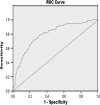The development of anemia is associated to poor prognosis in NKF/KDOQI stage 3 chronic kidney disease
- PMID: 23295149
- PMCID: PMC3623844
- DOI: 10.1186/1471-2369-14-2
The development of anemia is associated to poor prognosis in NKF/KDOQI stage 3 chronic kidney disease
Abstract
Background: Anemia is a common condition in CKD that has been identified as a cardiovascular (CV) risk factor in end-stage renal disease, constituting a predictor of low survival. The aim of this study was to define the onset of anemia of renal origin and its association with the evolution of kidney disease and clinical outcomes in stage 3 CKD (CKD-3).
Methods: This epidemiological, prospective, multicenter, 3-year study included 439 CKD-3 patients. The origin of nephropathy and comorbidity (Charlson score: 3.2) were recorded. The clinical characteristics of patients that developed anemia according to EBPG guidelines were compared with those that did not, followed by multivariate logistic regression, Kaplan-Meier curves and ROC curves to investigate factors associated with the development of renal anemia.
Results: During the 36-month follow-up period, 50% reached CKD-4 or 5, and approximately 35% were diagnosed with anemia (85% of renal origin). The probability of developing renal anemia was 0.12, 0.20 and 0.25 at 1, 2 and 3 years, respectively. Patients that developed anemia were mainly men (72% anemic vs. 69% non-anemic). The mean age was 68 vs. 65.5 years and baseline proteinuria was 0.94 vs. 0.62 g/24h (anemic vs. non anemic, respectively). Baseline MDRD values were 36 vs. 40 mL/min and albumin 4.1 vs. 4.3 g/dL; reduction in MDRD was greater in those that developed anemia (6.8 vs. 1.6 mL/min/1.73 m2/3 years). These patients progressed earlier to CKD-4 or 5 (18 vs. 28 months), with a higher proportion of hospitalizations (31 vs. 16%), major CV events (16 vs. 7%), and higher mortality (10 vs. 6.6%) than those without anemia. Multivariate logistic regression indicated a significant association between baseline hemoglobin (OR=0.35; 95% CI: 0.24-0.28), glomerular filtration rate (OR=0.96; 95% CI: 0.93-0.99), female (OR=0.19; 95% CI: 0.10-0.40) and the development of renal anemia.
Conclusions: Renal anemia is associated with a more rapid evolution to CKD-4, and a higher risk of CV events and hospitalization in non-dialysis-dependent CKD patients. This suggests that special attention should be paid to anemic CKD-3 patients.
Figures



References
-
- Whaley-Connell A, Sowers JR, McCullough PA, Roberts T, McFarlane SI, Chen SC, Li S, Wang C, Collins AJ, Bakris GL. Diabetes mellitus and CKD awareness: the Kidney Early Evaluation Program (KEEP) and National Health and Nutrition Examination Survey (NHANES) Am J Kidney Dis. 2009;53(4 Suppl 4):S11–S21. - PubMed
-
- Otero A, de Francisco A, Gayoso P, Garcia F. Prevalence of chronic renal disease in Spain: results of the EPIRCE study. Nefrologia. 2010;30(1):78–86. - PubMed
-
- ERA/EDTA. Revised European Best Practice Guidelines for the Management of Anaemia in Patients with Chronic Renal Failure. Anaemia evaluation. Nephrol Dial Transplant. 2004;19(Suppl. 2):ii2–ii5. - PubMed
Publication types
MeSH terms
LinkOut - more resources
Full Text Sources
Other Literature Sources
Medical

